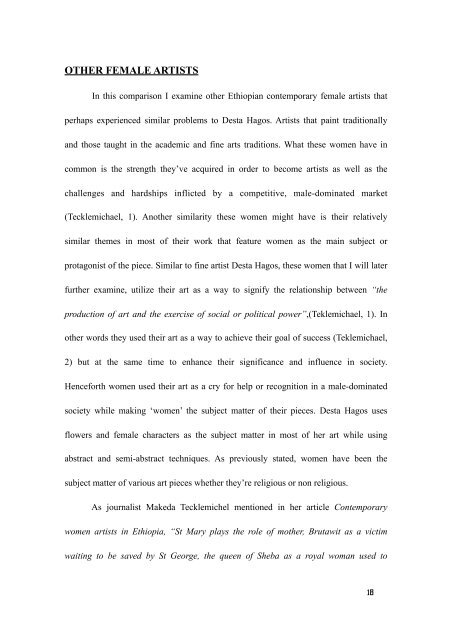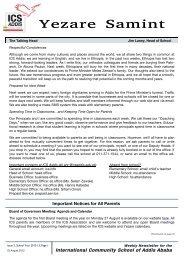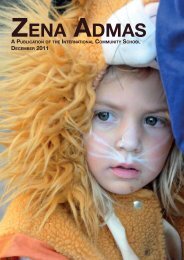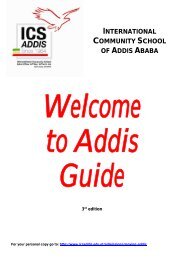Aida Buzuayehu - International Community School of Addis Ababa
Aida Buzuayehu - International Community School of Addis Ababa
Aida Buzuayehu - International Community School of Addis Ababa
You also want an ePaper? Increase the reach of your titles
YUMPU automatically turns print PDFs into web optimized ePapers that Google loves.
OTHER FEMALE ARTISTS<br />
In this comparison I examine other Ethiopian contemporary female artists that<br />
perhaps experienced similar problems to Desta Hagos. Artists that paint traditionally<br />
and those taught in the academic and fine arts traditions. What these women have in<br />
common is the strength they’ve acquired in order to become artists as well as the<br />
challenges and hardships inflicted by a competitive, male-dominated market<br />
(Tecklemichael, 1). Another similarity these women might have is their relatively<br />
similar themes in most <strong>of</strong> their work that feature women as the main subject or<br />
protagonist <strong>of</strong> the piece. Similar to fine artist Desta Hagos, these women that I will later<br />
further examine, utilize their art as a way to signify the relationship between “the<br />
production <strong>of</strong> art and the exercise <strong>of</strong> social or political power”,(Teklemichael, 1). In<br />
other words they used their art as a way to achieve their goal <strong>of</strong> success (Teklemichael,<br />
2) but at the same time to enhance their significance and influence in society.<br />
Henceforth women used their art as a cry for help or recognition in a male-dominated<br />
society while making ‘women’ the subject matter <strong>of</strong> their pieces. Desta Hagos uses<br />
flowers and female characters as the subject matter in most <strong>of</strong> her art while using<br />
abstract and semi-abstract techniques. As previously stated, women have been the<br />
subject matter <strong>of</strong> various art pieces whether they’re religious or non religious.<br />
As journalist Makeda Tecklemichel mentioned in her article Contemporary<br />
women artists in Ethiopia, “St Mary plays the role <strong>of</strong> mother, Brutawit as a victim<br />
waiting to be saved by St George, the queen <strong>of</strong> Sheba as a royal woman used to<br />
18














